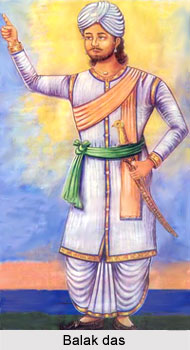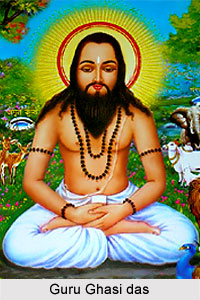 The Satnamis of Chhattisgarh were a group of people, who formed a socio-religious movement in Bengal during the British period. The movement was founded and led by Ghasi Das of Bilaspur district and he was thought to be an untouchable leather worker (Chamar). He was a servant in the villages of Girod in Raipur district during his adulthood. He and his brother went for a pilgrimage to the Vaishnava temple of Puri in Orissa, sometime during the 1820s. However, they did not complete the journey and they returned after reaching Sarangarh. After returning from the pilgrimage, Ghasi Das started to reject the social inequality and caste system and he gradually gained popularity among the lower caste people.
The Satnamis of Chhattisgarh were a group of people, who formed a socio-religious movement in Bengal during the British period. The movement was founded and led by Ghasi Das of Bilaspur district and he was thought to be an untouchable leather worker (Chamar). He was a servant in the villages of Girod in Raipur district during his adulthood. He and his brother went for a pilgrimage to the Vaishnava temple of Puri in Orissa, sometime during the 1820s. However, they did not complete the journey and they returned after reaching Sarangarh. After returning from the pilgrimage, Ghasi Das started to reject the social inequality and caste system and he gradually gained popularity among the lower caste people.
Ghasi Das soon gathered a group of people to spread his ideas and thoughts. He and his followers are popularly known as the Satnamis of Chhattisgarh. Although everyone was welcomed to join the group, most of his companions belonged to the Chamar caste. Ghasi Das preached a new religious doctrine and advised his followers to abandon idol worship and all that it entailed. He believed that all men in the world are equal. He also urged his followers to restructure their dietary practices and to avoid taking meat, liquor and anything that resembled flesh or blood. The dietary restrictions were also applicable for the vegetables like tomatoes, lentils and chillies. Apart from diet and basic belief, Ghasi Das also asked his followers to refrain from using cattle for ploughing after midday or from taking food out to the fields. However, though he advocated the dietary changes, Ghasi Das brought his untouchable disciples in compliance with the upper-caste customs.
The primary focus of the Satnamis of Chhattisgarh was to improve the status of the Chamars in the society through adjustments within the untouchable society. After the death of Ghasi Das in 1850, his eldest son, Balak Das became the leader of the Satnamis. He adopted the sacred thread that was worn only by the first three Varnas of the society. Balak Das was aggressive and radical in his attitudes to caste discrimination and mainly because of his aggressive moves; a group of Rajputs assassinated him in the 1860s.
 The murder of Balak Das triggered a social protest and rebellion against the upper castes among the Satnamis and the conflict led to riots and further murders. The next leader of the Satnamis of Chhattisgarh was Sahib Das, the son of Balak Das. However, the real control of the group rested with a brother of the founder, named Agar Das. After the death of Sahib Das, the two sons of Agar Das, namely Ajab Das and Agarman Das became the leaders of the Satnamis of Chhattisgarh.
The murder of Balak Das triggered a social protest and rebellion against the upper castes among the Satnamis and the conflict led to riots and further murders. The next leader of the Satnamis of Chhattisgarh was Sahib Das, the son of Balak Das. However, the real control of the group rested with a brother of the founder, named Agar Das. After the death of Sahib Das, the two sons of Agar Das, namely Ajab Das and Agarman Das became the leaders of the Satnamis of Chhattisgarh.
However, the Satnamis of Chhattisgarh soon witnessed a split among themselves. Two groups of Satnamis started debating over a ban on tobacco and smoking, which was laid by Ghasi Das during the foundation of the group. One group claimed that Ghasi Das did lift the ban before his death and they eventually broke away from the parent group. This new sub sect of the Satnamis became popular as Chungias and soon, another subdivision of the Satnamis came into existence. This sub sect was comprised of the Jahorias and hence was named as Johar (essence). Mainly the Satnamis who took vows of mendicancy were involved with the Johar sub sect. They ate only pulses and rice, wore only uncoloured clothes and they never slept on bed.
The Satnamis of Chhattisgarh rejected all the Hindu deities, temples and the authority of Brahmins and they also gave a call to believe only in one formless God - Satnam (meaning true name). The formation of Satnam-Panth by the Chamars was actually a reaction to their economic and cultural exploitation. The traditional agricultural economy made their survival difficult and they also had to put up with subordination in the matter of rituals owing to their "impure" occupation. The Satnamis appropriated and rejected signs and symbols of the caste system. They rejected the dominant status of Brahmins; however, they adopted signs of ritual purity. They were aimed at removing the "impurities of the bodies of its members".
The Satnamis of Chhattisgarh started to grow in numbers with the course of time and a majority of the Chamar community of Chhattisgarh joined them very soon. Chhattisgarh was the centre of this movement and most of the Satnamis were concentrated within this state. The Satnamis of Chhattisgarh also became a permanent subdivision of the Hindus in the Central Provinces, during the British period.
The movement led by the Satnamis of Chhattisgarh was actually a single-caste socio-religious movement with its own hierarchical system of priests, its sacred centres and a calendar of ritual events. The movement persisted as an untouchable form of Hinduism and its area of impact was mainly limited to Chhattisgarh plain.



















